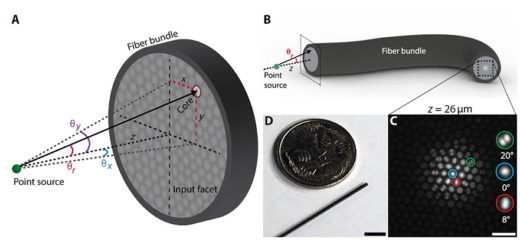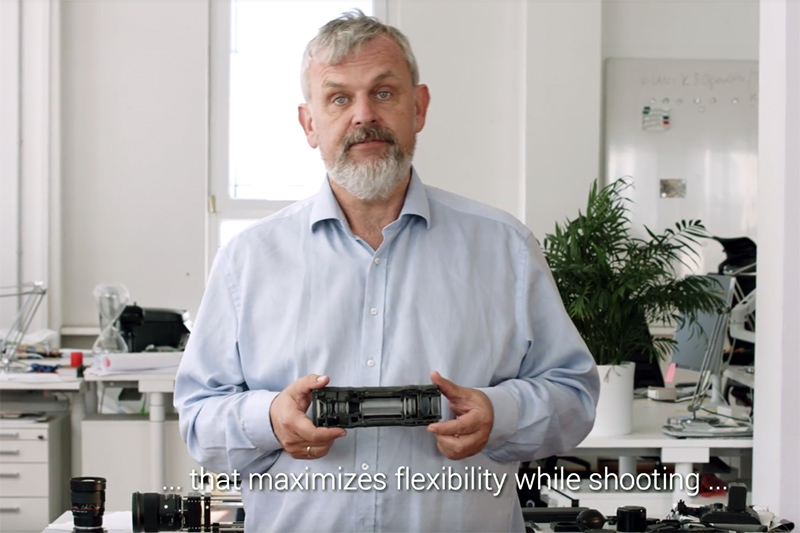Photokina Preview: Raytrix demoes Live 3D LightField Processing
In a news release that has somehow escaped our notice, German LightField specialist Raytrix announced an exclusive live demonstration at Photokina Preview 2012.
The report notes that Dr. Lennart Wietzke (Raytrix co-founder and CEO) and his team presented “the current version of the LightField camera”, and showed off live 3D LightField data processing, as well as software refocus. (Note: Raytrix is not participating in the Photokina conference itself.)
Die Funktionsweise der Lichtfeldkamera wird erst am Computermonitor sichtbar. Wietzkes Team zeigt das exklusiv auf der PREVIEW zur photokina am Präsentationsstand. Mit einem Mausklick fährt der Raytrix-Mitarbeiter den Schärfepunkt in eine beliebige Entfernung des Motivs.
The report includes some interesting details about Raytrix’ technology:
The presented camera has a final resolution of up to 3 Megapixels, so the author is probably talking about the Raytrix R11 camera.
The microlenses in use have a focal length of 0.05 mm (or 50 µm) and create sub-images of 20 x 20 pixels each. At 10.7 megarays, and 400 square pixels per sub-image, we can estimate the number of microlenses at 26.750.
The full report (in German) and more photos can be found here: Die Schärfe kommt erst nach dem Auslösen








Here is the english text translation of the above article
The sharpness comes after the triggering
3D images through light field camera with a lens
PREVIEW online – Dr. Lennart Wietzke, CEO of Raytrix, introduces the latest version of the light field camera. With its three-dimensional images are possible and with only one lens. However, is focused only on the actual image. The secret lies in the micro-lens array system and the actual post with special software on the computer.
Dr. Lennart has Wietzke Raytrix habil with Dr. Christian Perwaß founded in 2008. Since 2009 to develop and sell the two entrepreneurs through its offices cameras for industrial applications – such as 3D object recognition for quality assurance. Other possible applications are in the areas multilayer microscopy, traffic monitoring, research and development, TV production, security systems and many more. From a single image capture can Raytrix camera systems based on light-field technology compute 3D depth maps and different image views automatically. The 3D depth information of face images to be materially better identify classify faces or. The 3D depth types calculating the light field cameras from a single image pickup improve additional 3D information, such as the 2D image segmentation algorithms. In the light field photography, the photographer simply presses the shutter, without any mechanical changes that were previously in the lens necessary. The focus is behind the computer. Conventional 3D photography solves the problem of lack of information on the distance of an object with two cameras taking the object from slightly different directions or angles better. The cameras are similar in structure to human eyes identical, their distance is fixed, a subsequent move is not possible. The light field photography is here further: It refers to the object of thousands of different angles – draws so from the light coming through the lens , multiple direction information. “The point of the object exploded in literally a two-dimensional surface from multiple sensor pixels,” says Lennart Wietzke. He describes it as a combination of a conventional camera and insect eye. Lens and housing are hardly different from today’s SLRs. The difference is a matrix of many microlenses sitting twentieth of a millimeter in front of the sensor and a little like the compound eye of a fly looks. The microlenses direct the light that is received from the object from a particular direction, at 20 by 20 pixels of the sensor. Because a light field camera requires pixel to record the directions of the light rays, fewer pixels are available to represent the object. The resolution decreases. The Raytrix software produces images with a maximum 3 megapixels. Thus, the image resolution is still below that of simple cell phone cameras. In principle, the resolution up to a light field camera are no limits, provided the bank account of the buyer has no limit. Operation of the light field camera is only visible on the computer monitor. Wietzkes team shows exclusively on the PREVIEW photokina on presentation stand. With a mouse moves the Raytrix employees the focal point in any subject distance. Each photographer usually turns to the distance of his camera lens ring or can automatically run from the autofocus. This happens before the shutter is pressed, the light field technology only after receiving the photos. Sets are by this approach include blurring the future of the past. Since it regulates not only around the long distance setting, but can instantly snap the photo, and then sets everything later on your home computer. What is behind the light field photography? Today’s cameras compress the 3D object image on the two-dimensional surface of the sensor. The information, where the light from entering the lens and from there fell on the sensor goes, lost. Exactly these data records the light field camera (with). It can then calculate the associated software, the distance at which an object has been found. Known, are usually not always two objects that appear in a photo next to each other, actually next to each other. Realistically could be many meters are in a row. http://www.raytrix.de
Photo (7)
Dr. Lennart Wietzke, CEO of Raytrix, introduces the latest version of the light field camera. PREVIEW
Today’s cameras compress the 3D object image on the two-dimensional surface of the sensor. The information, where the light from entering the lens and from there fell on the sensor goes, lost. Exactly these data records the light field camera (with). It can then calculate the associated software, the distance at which an object has been found. PREVIEW
The operation of the light field camera is only visible on the computer monitor. Wietzkes team shows exclusively on the PREVIEW photokina on presentation stand. PREVIEW
With a mouse moves the Raytrix employees the focal point in any subject distance. Each photographer usually turns to the distance of his camera lens ring or can automatically run from the autofocus. This happens before the shutter is pressed, the light field technology only after receiving the photos. PREVIEW
What is behind the light field photography? Today’s cameras compress the 3D object image on the two-dimensional surface of the sensor. The information, where the light from entering the lens and from there fell on the sensor goes, lost. Exactly these data records the light field camera (with). PREVIEW
From the mitaufgezeicheten “distance data” can calculate the associated software, the distance at which an object has been found. PREVIEW
Dr. Lennart Wietzke has Raytrix habil with Dr. Christian Perwaß founded in 2008. Development since 2009 and the two entrepreneurs sell its offices cameras for industrial applications – such as 3D object recognition for quality assurance. PREVIEW